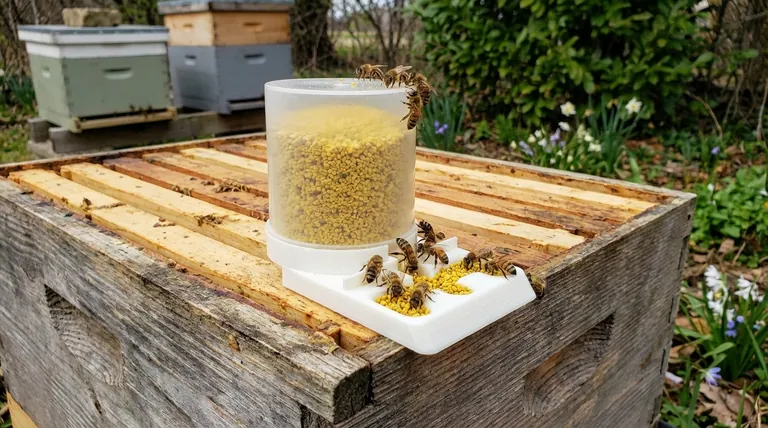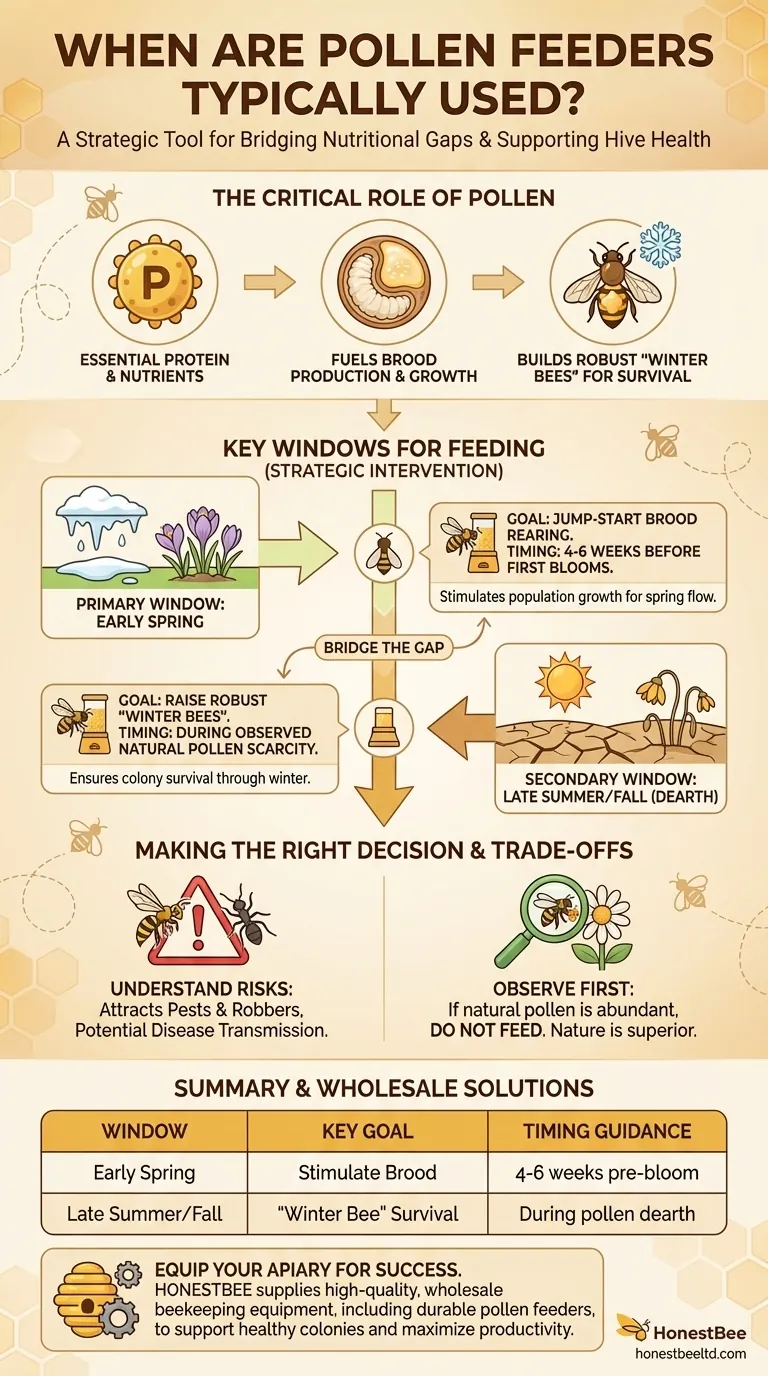Pollen feeders are a strategic tool used during specific periods of natural pollen scarcity to support a hive's growth and health. They are most commonly deployed in early spring to stimulate brood rearing before flowers bloom, and sometimes again in late summer or early fall if a pollen dearth occurs.
Feeding pollen is not about providing a constant food source, but about bridging a critical protein gap. This intervention is timed to fuel brood production when the colony needs to grow but natural resources are unavailable.

The Critical Role of Pollen in Hive Health
Pollen is the Hive's Only Protein
Pollen is the essential protein, fat, vitamin, and mineral source for honey bees. While honey provides carbohydrates for energy, pollen is the nutrient-dense food required for growth and development.
Fueling Brood Production
A queen bee's egg-laying rate is directly tied to the amount of incoming pollen. Nurse bees consume pollen to produce the royal jelly needed to feed the queen and, most importantly, the young larvae (brood). Without adequate protein, brood rearing slows or stops entirely.
Building Strong "Winter Bees"
In the fall, bees consume pollen to build up fat stores in their bodies. This creates a generation of "winter bees" that are physiologically equipped to survive the long, cold months and care for the first round of spring brood.
Key Windows for Pollen Feeding
Primary Window: Early Spring
This is the most critical and common time to use a pollen feeder. As days lengthen, the queen is biologically driven to start laying eggs, but freezing temperatures or snow cover mean no natural pollen is available.
Providing a pollen substitute during this period allows the colony to begin raising brood weeks before the first flowers appear. This jump-starts population growth, leading to a much stronger workforce宗教 for the spring nectar flow.
Secondary Window: Late Summer/Early Fall
This period, often in August and September, can bring a "dearth"—a time when high heat and dry conditions cause flowers to stop producing nectar and pollen.
Feeding during a fall dearth ensures the colony can raise that final, crucial generation of robust winter bees. A lack of protein in the fall can lead to a weaker cluster that struggles to survive winter.
Understanding the Trade-offs
Attracting Pests and Robbers
Open pollen feeders are not selective. They can attract ants, wasps, and bees from neighboring hives, which can lead to robbing and stress on your colony.
Potential for Disease Transmission
Because open-feeding stations attract bees from other apiaries, they can become a vector for transmitting diseases and mites between colonies. This is a significant risk to hive health.
Relying on Observation, Not the Calendar
The decision to feed should be based on observing your local environment and your hives, not just the time of year. If your bees are bringing in large, colorful balls of natural pollen, there is no need to provide a substitute.
Making the Right Decision for Your Hive
Deciding when to feed pollen is a matter of aligning your intervention with the hive's biological needs and the availability of natural forage.
- If your primary focus is rapid spring buildup: Begin feeding a pollen substitute in late winter or very early spring, about 4-6 weeks before you expect the first natural pollen to become available.
- If you are preparing for winter in a dry climate: Monitor your hives in late summer and feed a pollen substitute if you notice a complete lack of natural pollen coming in.
- If your bees have access to abundant natural pollen: Do not feed. Natural pollen is always superior, and supplemental feeding is unnecessary and introduces risks.
Ultimately, your role is to support the hive's natural cycle, intervening only when a clear nutritional gap exists.
Summary Table:
| Feeding Window | Key Goal | Timing Guidance |
|---|---|---|
| Early Spring | Stimulate brood rearing before natural pollen is available. | Start 4-6 weeks before the first blooms appear. |
| Late Summer/Fall | Raise robust "winter bees" to ensure colony survival. | Feed if a natural pollen dearth is observed. |
Ensure your apiary thrives through every season with the right equipment. HONESTBEE supplies commercial apiaries and beekeeping equipment distributors with high-quality, wholesale-focused beekeeping supplies. From durable pollen feeders to essential hive tools, we provide the reliable equipment you need to support healthy colonies and maximize productivity. Contact our experts today to discuss your wholesale needs and build a stronger operation.
Visual Guide

Related Products
- HONESTBEE Entrance Bee Feeder Professional Hive Nutrition Solution for Beekeeping
- In-Hive Dual Compartment Frame Bee Feeder for Targeted Colony Nutrition
- HONESTBEE Professional Entrance Bee Feeder Hive Nutrition Solution
- Rapid Bee Feeder White Plastic 2L Round Top Feeder for 8 or 10-Frame Bee Hives
- Classic Boardman Entrance Bee Feeder Hive Front Feeding Solution
People Also Ask
- How do you make an entrance feeder for bees? A Guide to Safe & Effective Hive Feeding
- How to make an entrance feeder for bees? A DIY Guide for Safe & Effective Feeding
- What are the different types of honey bee feeders? Choose the Right Feeder for Your Hive
- How is the mesh ladder and barrier installed in the feeder box? A Step-by-Step Guide to Prevent Bee Drowning
- What are the common types of honey bee feeders? Choose the Right Feeder for Your Hive



















